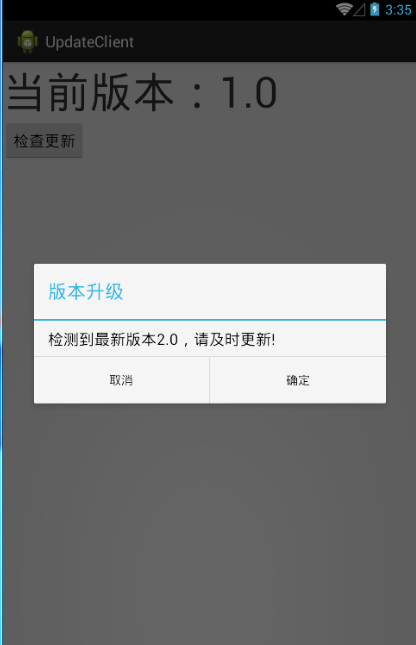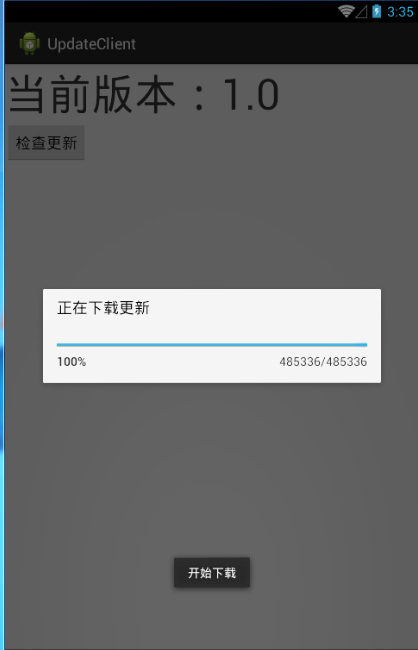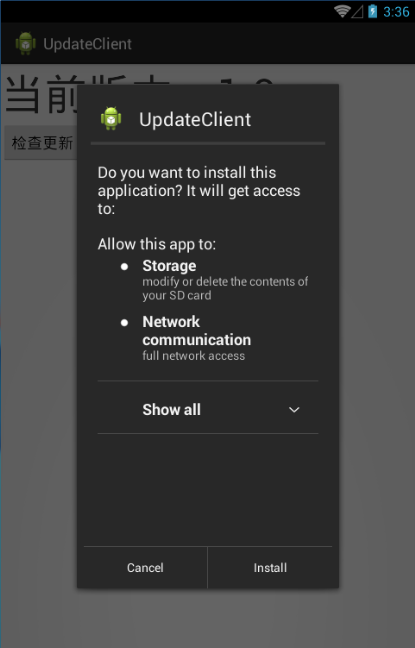[Android通信]版本更新
2015-11-08 13:27
525 查看
参考链接:
http://www.cnblogs.com/hxsyl/archive/2014/05/14/3727291.html
环境:
MyEclipse + 局域网
pc在局域网中的IP地址:
在控制面板---网络和Internet---网络和共享中心,点击本地连接---详细信息,其中IPv4地址即为局域网IP地址。
1.服务器端
新建一个web project,命名为UpdateServer,然后开启tomcat服务器,并把UpdateServer部署在服务器上。然后在UpdateServer/WebRoot下新建一个json文件,命名为version,添加如下的内容:
{
"version":"2.0",
"apk":"http://172.25.225.24:8080/UpdateServer/UpdateClient.apk",
"description":"检测到最新版本2.0,请及时更新!"
}
然后在浏览器输入:http://172.25.225.24:8080/UpdateServer/version.json,如果访问成功,则浏览器会出现下载json文件的提示。
172.25.225.24是pc在局域网中的IP地址,8080是tomcat的端口号
2.客户端
新建一个android project,命名为UpdateClient,然后在strings.xml中添加:
<string name="version_server">http://172.25.225.24:8080/UpdateServer/version.json</string>当检查版本更新时,就可以访问这个url获取服务器的版本信息了。
在AndroidManifest.xml中添加访问网络和sd卡的权限:
<uses-permission android:name="android.permission.INTERNET"/>
<uses-permission android:name="android.permission.WRITE_EXTERNAL_STORAGE"/>
package com.example.updateclient;
public class VersionInfo {
private String version;
private String apk;
private String description;
public String getVersion() {
return version;
}
public void setVersion(String version) {
this.version = version;
}
public String getApk() {
return apk;
}
public void setApk(String apk) {
this.apk = apk;
}
public String getDescription() {
return description;
}
public void setDescription(String description) {
this.description = description;
}
}
需要用到volley的jar包,下载地址:
http://pan.baidu.com/s/1c0HiMnY
3.测试
在AndroidManifest.xml中修改android:versionName为2.0,然后修改布局文件的TextView为"当前版本:2.0",打包android工程,把apk放在UpdateServer/WebRoot下。这个就是新版的apk了。
在AndroidManifest.xml中修改android:versionName为1.0,然后修改布局文件的TextView为"当前版本:1.0",打包android工程,把apk运行在模拟器上。




http://www.cnblogs.com/hxsyl/archive/2014/05/14/3727291.html
环境:
MyEclipse + 局域网
pc在局域网中的IP地址:
在控制面板---网络和Internet---网络和共享中心,点击本地连接---详细信息,其中IPv4地址即为局域网IP地址。
1.服务器端
新建一个web project,命名为UpdateServer,然后开启tomcat服务器,并把UpdateServer部署在服务器上。然后在UpdateServer/WebRoot下新建一个json文件,命名为version,添加如下的内容:
{
"version":"2.0",
"apk":"http://172.25.225.24:8080/UpdateServer/UpdateClient.apk",
"description":"检测到最新版本2.0,请及时更新!"
}
然后在浏览器输入:http://172.25.225.24:8080/UpdateServer/version.json,如果访问成功,则浏览器会出现下载json文件的提示。
172.25.225.24是pc在局域网中的IP地址,8080是tomcat的端口号
2.客户端
新建一个android project,命名为UpdateClient,然后在strings.xml中添加:
<string name="version_server">http://172.25.225.24:8080/UpdateServer/version.json</string>当检查版本更新时,就可以访问这个url获取服务器的版本信息了。
在AndroidManifest.xml中添加访问网络和sd卡的权限:
<uses-permission android:name="android.permission.INTERNET"/>
<uses-permission android:name="android.permission.WRITE_EXTERNAL_STORAGE"/>
package com.example.updateclient;
public class VersionInfo {
private String version;
private String apk;
private String description;
public String getVersion() {
return version;
}
public void setVersion(String version) {
this.version = version;
}
public String getApk() {
return apk;
}
public void setApk(String apk) {
this.apk = apk;
}
public String getDescription() {
return description;
}
public void setDescription(String description) {
this.description = description;
}
}
package com.example.updateclient;
import java.io.BufferedInputStream;
import java.io.File;
import java.io.FileOutputStream;
import java.io.InputStream;
import java.net.HttpURLConnection;
import java.net.URL;
import android.app.ProgressDialog;
import android.os.Environment;
public class DownLoadManager {
public static File getFileFromServer(String path, ProgressDialog pd) throws Exception {
//如果相等的话表示当前的sdcard挂载在手机上并且是可用的
if(Environment.getExternalStorageState().equals(Environment.MEDIA_MOUNTED)){
URL url = new URL(path);
HttpURLConnection conn = (HttpURLConnection) url.openConnection();
conn.setConnectTimeout(5000);
//获取到文件的大小
pd.setMax(conn.getContentLength());
File file = new File(Environment.getExternalStorageDirectory(), "update.apk");
FileOutputStream fos = new FileOutputStream(file);
InputStream is = conn.getInputStream();
BufferedInputStream bis = new BufferedInputStream(is);
byte[] buffer = new byte[1024];
int len;
int total = 0;
while((len =bis.read(buffer)) != -1){
fos.write(buffer, 0, len);
total += len;
//获取当前下载量
pd.setProgress(total);
}
fos.close();
bis.close();
is.close();
return file;
}
else {
return null;
}
}
}package com.example.updateclient;
import java.io.File;
import org.json.JSONException;
import org.json.JSONObject;
import com.android.volley.RequestQueue;
import com.android.volley.Response;
import com.android.volley.Response.Listener;
import com.android.volley.VolleyError;
import com.android.volley.toolbox.JsonObjectRequest;
import com.android.volley.toolbox.Volley;
import android.app.Activity;
import android.app.AlertDialog;
import android.app.AlertDialog.Builder;
import android.app.ProgressDialog;
import android.content.DialogInterface;
import android.content.Intent;
import android.content.pm.PackageInfo;
import android.content.pm.PackageManager;
import android.content.pm.PackageManager.NameNotFoundException;
import android.net.Uri;
import android.os.Bundle;
import android.util.Log;
import android.view.View;
import android.view.View.OnClickListener;
import android.widget.Button;
import android.widget.Toast;
public class MainActivity extends Activity {
private RequestQueue requestQueue;
private VersionInfo versionInfo;
@Override
protected void onCreate(Bundle savedInstanceState) {
super.onCreate(savedInstanceState);
setContentView(R.layout.activity_main);
requestQueue = Volley.newRequestQueue(getApplicationContext());
versionInfo = new VersionInfo();
((Button)findViewById(R.id.checkUpdate)).setOnClickListener(new OnClickListener() {
@Override
public void onClick(View v) {
checkVersion();
}
});
}
//获取客户端的版本信息
private String getClientVersion()
{
//getPackageName()是你当前类的包名,0代表是获取版本信息
PackageManager packageManager = getPackageManager();
PackageInfo packInfo = null;
try {
packInfo = packageManager.getPackageInfo(getPackageName(),0);
} catch (NameNotFoundException e) {
e.printStackTrace();
}
return packInfo.versionName;
}
//检查版本信息
private void checkVersion()
{
String url = getResources().getString(R.string.version_server);
JsonObjectRequest jor = new JsonObjectRequest(url, null, new Listener<JSONObject>() {
@Override
public void onResponse(JSONObject response) {
try {
versionInfo.setVersion(response.getString("version"));
versionInfo.setApk(response.getString("apk"));
versionInfo.setDescription(response.getString("description"));
if(getClientVersion().equalsIgnoreCase(versionInfo.getVersion())) {
Toast.makeText(getApplicationContext(), "已是最新版本", Toast.LENGTH_SHORT).show();
} else {
showUpdataDialog();
}
} catch (JSONException e) {
e.printStackTrace();
}
}
}, new Response.ErrorListener() {
@Override
public void onErrorResponse(VolleyError error) {
Log.v("error", error.toString());
}
});
requestQueue.add(jor);
}
/*
* 弹出对话框的步骤:
* 1.创建alertDialog的builder.
* 2.要给builder设置属性, 对话框的内容,样式,按钮
* 3.通过builder 创建一个对话框
* 4.对话框show()出来
*/
private void showUpdataDialog() {
AlertDialog.Builder builer = new Builder(MainActivity.this);
builer.setTitle("版本升级");
builer.setMessage(versionInfo.getDescription());
builer.setPositiveButton("确定", new DialogInterface.OnClickListener() {
@Override
public void onClick(DialogInterface dialog, int which) {
Toast.makeText(getApplicationContext(), "开始下载", Toast.LENGTH_SHORT).show();
downLoadApk();
}
});
builer.setNegativeButton("取消", new DialogInterface.OnClickListener() {
@Override
public void onClick(DialogInterface dialog, int which) {
Toast.makeText(getApplicationContext(), "取消下载", Toast.LENGTH_SHORT).show();
}
});
AlertDialog dialog = builer.create();
dialog.show();
}
private void downLoadApk() {
final ProgressDialog pd = new ProgressDialog(MainActivity.this);
pd.setProgressStyle(ProgressDialog.STYLE_HORIZONTAL);
pd.setMessage("正在下载更新");
pd.show();
new Thread() {
public void run() {
try {
File file = DownLoadManager.getFileFromServer(versionInfo.getApk(), pd);
sleep(3000);
installApk(file);
pd.dismiss();//结束掉进度条对话框
} catch (Exception e) {
e.printStackTrace();
}
};
}.start();
}
private void installApk(File file) {
Intent intent = new Intent();
//执行动作
intent.setAction(Intent.ACTION_VIEW);
//执行的数据类型
intent.setDataAndType(Uri.fromFile(file), "application/vnd.android.package-archive");
startActivity(intent);
}
}<LinearLayout xmlns:android="http://schemas.android.com/apk/res/android" xmlns:tools="http://schemas.android.com/tools" android:layout_width="match_parent" android:layout_height="match_parent" android:orientation="vertical" > <TextView android:layout_width="wrap_content" android:layout_height="wrap_content" android:text="当前版本:1.0" android:textSize="50sp" /> <Button android:id="@+id/checkUpdate" android:layout_width="wrap_content" android:layout_height="wrap_content" android:text="检查更新" /> </LinearLayout>
需要用到volley的jar包,下载地址:
http://pan.baidu.com/s/1c0HiMnY
3.测试
在AndroidManifest.xml中修改android:versionName为2.0,然后修改布局文件的TextView为"当前版本:2.0",打包android工程,把apk放在UpdateServer/WebRoot下。这个就是新版的apk了。
在AndroidManifest.xml中修改android:versionName为1.0,然后修改布局文件的TextView为"当前版本:1.0",打包android工程,把apk运行在模拟器上。




相关文章推荐
- Android studio 0.2.11发布
- Android studio 0.3.0发布
- iOS 项目如何实现版本的更新?
- AppStore审核新规则:带有版本更新的App将被拒绝
- ios 版本更新
- iOS开发版本更新和数据更新检测思路 —— HERO博客
- iOS检测版本更新
- iOS通过iTunes search检测版本更新,并提示用户更新!
- iOS版本检测更新
- IOS版本更新
- ios项目如何实现版本更新?
- ios版本监测与更新
- Xamarin.iOS使用itunes信息更新版本更新
- IOS 版本更新检测
- svn搭建
- android 版本检测与自动更新
- Android 轻松实现后台搭建+APP版本更新
- 微软发布Silverlight 4新版并更新Silverlight Tools和SDK 推荐
- Android----- 版本更新和 服务器下载新版本APK并安装
- tomcat自动更新版本的脚本
